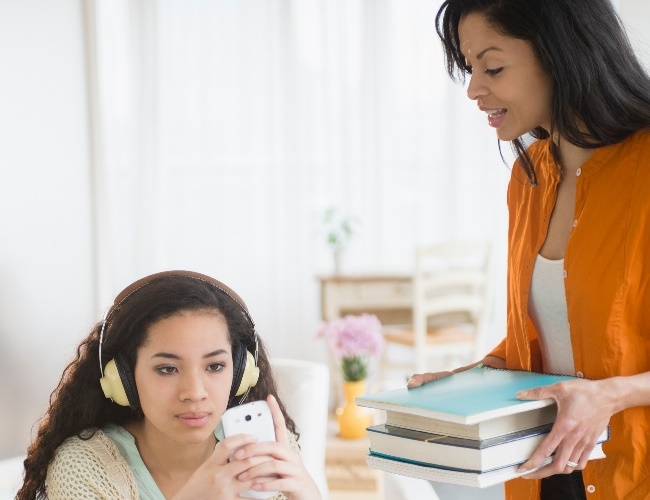
But, Mom, it’s the only way I can be in touch with my friends!”
If you have a teenager in your home, chances are you’ve heard this line a lot over the past months – probably every time you’ve tried to get them off their phones.
Lockdown certainly hasn’t made managing our kids’ time on their phones any easier. Even if they’ve been at school and had some contact with friends, their mobile devices are primarily how they chat to their mates these days.
Then there’s the fact that many teachers have sent online learning materials via WhatsApp while kids were doing their schooling at home, making setting limits for screen time even trickier.
This means a bit more effort is required when it comes to managing how tweens and teens use their phones.
It’s not a matter of debate whether excessive use of electronic devices is bad for our kids’ mental health, says American psychologist Dr Jean Twenge.
“Four large studies of teens from the US and UK all show the same thing: happiness and mental health are highest at a half-hour to two hours of extracurricular digital media use a day,” she wrote in an article for Time magazine.
“Wellbeing then steadily decreases, with those who spend the most time online being the worst off.”
Talking to your child about how much time they spend on their phone is important, but simply agreeing on rules and limits is usually not enough. They won’t necessarily stick to them, so you’ll have to enforce them.
It can feel like an insurmountable task, especially if you consider the fights that can ensue, but there are parental-control tools that can make it easier for you to manage your child’s screen time.
Although tablets and laptops can be a challenge, phones are the most difficult to wean them off.
Here’s a guide to some parental-control tools that will allow you to manage your child’s phone usage and help them build healthy tech habits.
GOOGLE FAMILY LINK
Cost: free
Useful for kids under 13
This app can be downloaded on a parent’s iPhone or Android device to manage their child’s Android phone. The app will also need to be downloaded on your child’s phone. You can limit how much time your child spends on their mobile, set up a schedule for when the phone is inaccessible (for example, bedtime) and block your child’s access to the phone with one tap.
You can monitor what they’re using their phone for (how much time is spent on various apps) and your child will need your permission to download apps. You can also completely block the use of specific apps.
But you can’t set time limits for individual apps, and another downside is that once your child is 13, they can sign up for a Google account on their own and opt out of the monitoring.
APPLE SCREEN TIME
Cost: free
Handy if all household devices are Apple products
This allows you to manage devices, purchases and screen usage across a household. Once you’ve set up Family Sharing and added your children to your account, you can set daily time limits on specific apps or categories of apps (social media, games and entertainment, for example).
You can set downtime to limit access to the phone at bedtime, and this can be customised for various days of the week. Unfortunately you can only do this for a block of time and can’t set up a schedule.
You can specify if you want your kids to be able to privately message other players within games. You can also set restrictions to block adult content on websites, explicit language in music, and age restrictions on apps, movies, TV shows and more. But this doesn’t apply to content from sources other than the Safari browser, including popular apps such as YouTube and TikTok.
A problem with downtime is also that when the browser remains open, your child can still access the internet.
OURPACT
Cost: free version; R108 ($6,99) or R154 ($9,99) monthly, depending on package
For iOS and Android
This app allows you to manage your child’s screen time, keep tabs on apps installed on your child’s device, block specific apps and set different management rules for educational apps versus social media ones. It also filters web content, has a family locator and you can block texting at specific times.
One of the latest features is something called View – it allows you to receive screenshots of your child’s device when it’s in use. The free version only allows you to set up a screen-time schedule on your child’s device.
For the advanced features, including the ability to block the phone or grant extra time with a single tap, you have to pay for the Premium or Premium + versions. Both plans include a one-week free trial before purchase.
QUSTODIO
Cost: free version; from $54,95 (R851) annually for five devices
For iOS and Android
With the free version you get basic controls such as daily screen-time limits, web filtering and time quotas for certain activities. But you’re restricted to a single device and it only keeps seven days of activity history.
The premium subscription-based plan allows you to set time limits on individual apps and block out more than one time period when the phone is off limits (for example during their afternoon homework session, dinnertime and bedtime).
You get a detailed activity log for up to 30 days, location tracking, monitor time spent on social media and can what your child searches for and watches on YouTube. You can also block access to the phone with a single tap.
It can be used across platforms so you can monitor and manage laptops and desktops as well.
Incognito mode may still be allowed on your child’s phone even if you’re using a parental control app. However, if you’ve blocked explicit content, this usually applies even if incognito mode is used. Check to be sure.
TIPS FOR PARENTS
Set some ground rules and talk to your kids about the benefits and the risks of being online, says Joburg-based social media law expert Emma Sadleir of The Digital Law Company.
“The internet has no shallow end and once kids are online, they’re exposed to all kinds of content,” says Sadleir, author of Selfies, Sexts and Smartphones: A Teenager’s Online Survival Guide. “The best line of defence is active, engaged, educated parents.”
She suggests the following to help kids learn to be responsible about phone usage:
- Discuss how many hours a day on their phone is reasonable and set those time limits on the device. Have a smartphone contract with your child that lays out ground rules, including time limits. You can download a contract for free on thedigitallawco.com.
- Make use of parental-control software or apps but remember, this shouldn’t replace frequent conversations and check-ins about how they’re spending their time online.
- Make it a rule that all devices must be out of the bedroom at a fixed time every night.
- Model good phone behaviour yourself – parents should also have screen-time limits. Agree on device- and media-free times for the family.




 Publications
Publications
 Partners
Partners


















